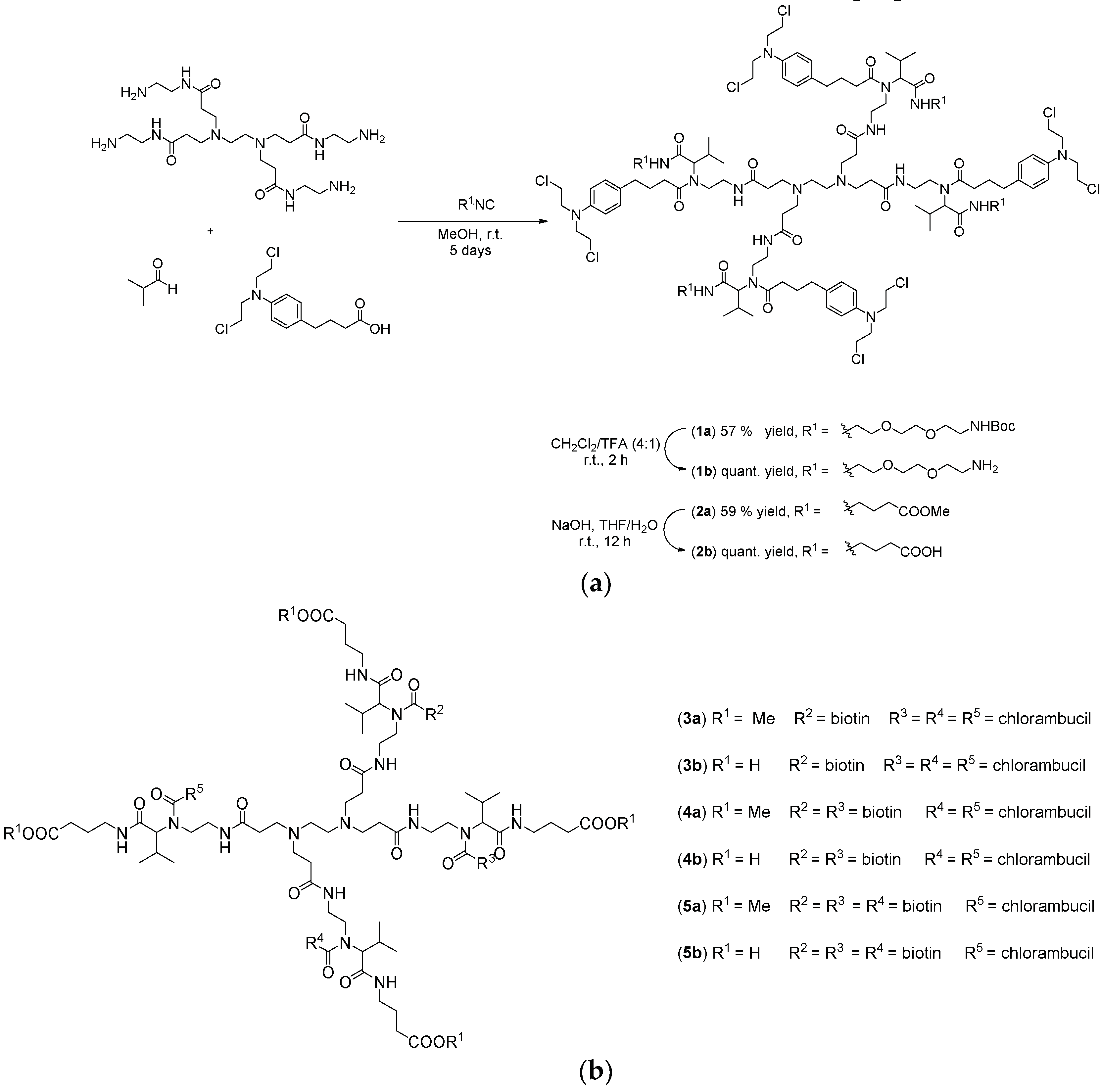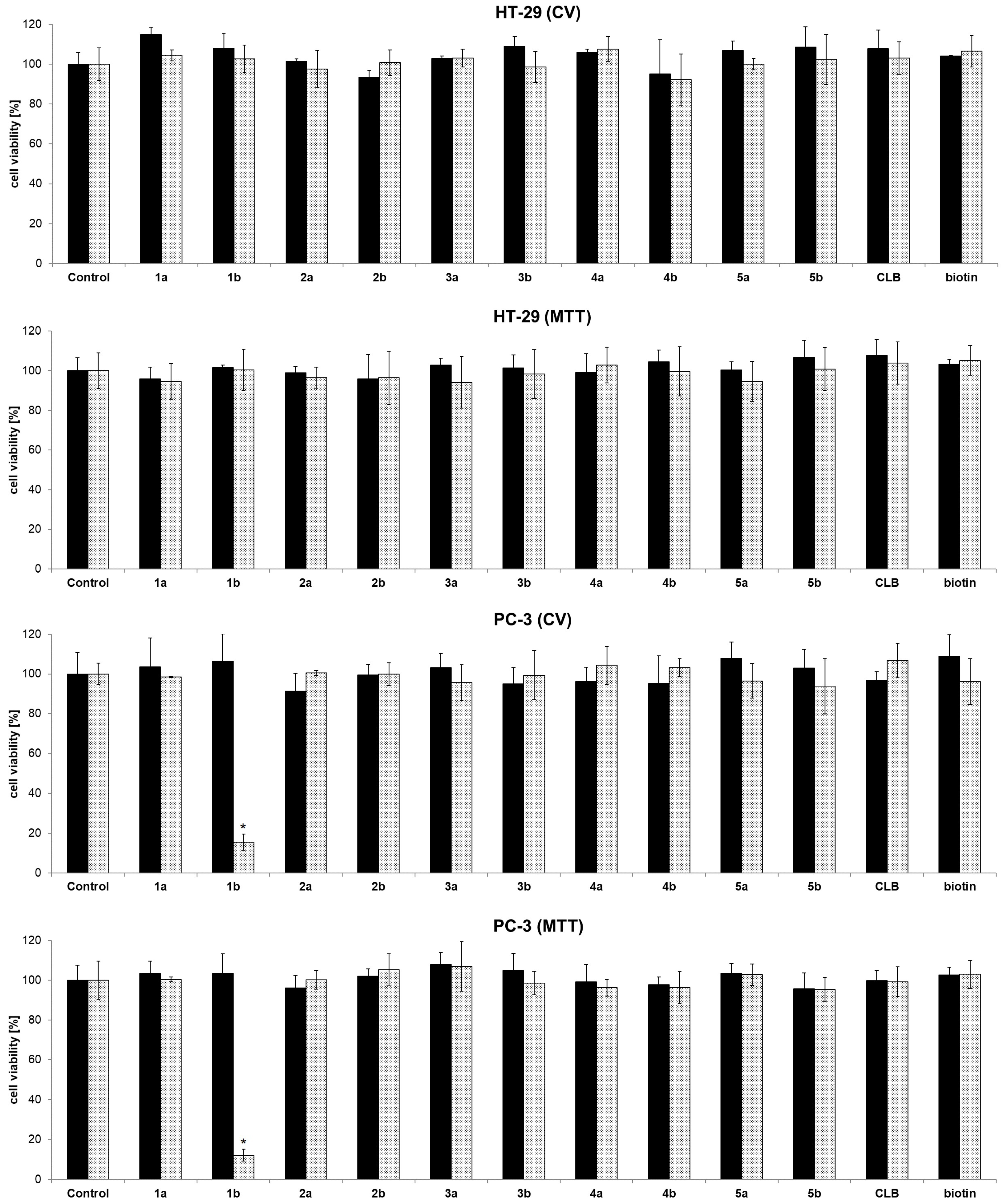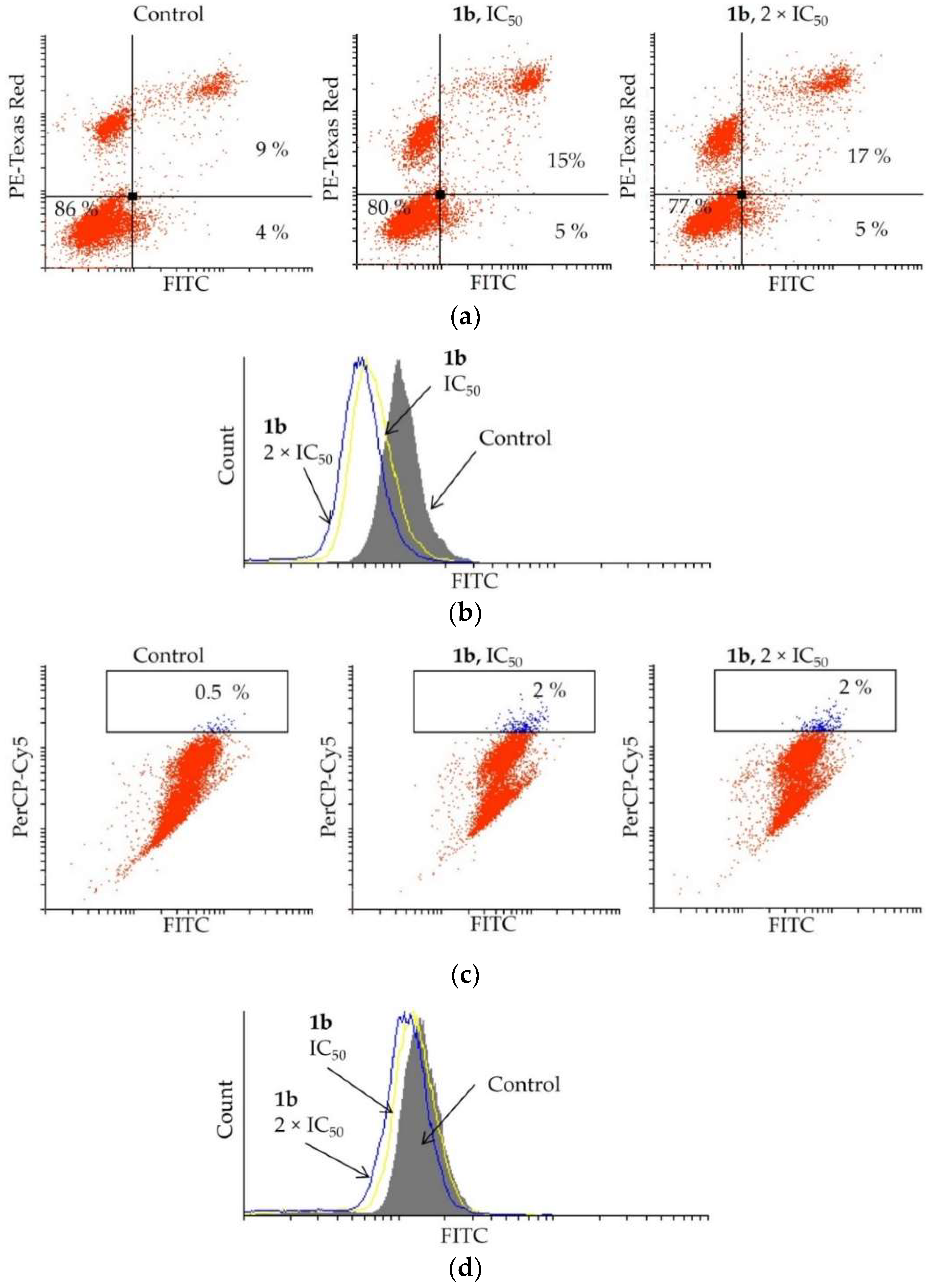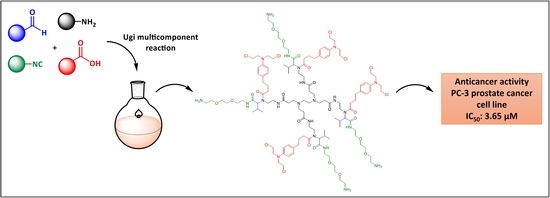Chlorambucil Conjugated Ugi Dendrimers with PAMAM-NH2 Core and Evaluation of Their Anticancer Activity
Abstract
1. Introduction
2. Materials and Methods
2.1. Materials
2.2. Analytical Methods
2.3. Synthesis of Dendrimers
2.3.1. General Procedure for the Synthesis of Dendrimers 1a and 2a
2.3.2. Synthesis of Dendrimer 1a
2.3.3. Synthesis of Dendrimer 2a
2.3.4. Synthesis of Dendrimer 1b
2.3.5. Procedure for the Synthesis of Dendrimer 2b
2.3.6. General Procedure for Synthesis of Dendrimers 3a–5a
2.3.7. General Procedure for the Synthesis of Dendrimers 3b–5b
- 3b: 3a (9.3 mg, 4 µmol) and NaOH (3 mg);
- 4b: 4a (18.8 mg, 8 µmol) and NaOH (6.4 mg);
- 5b: 5a (8 mg, 3 µmol) and NaOH (3 mg).
2.4. Cell Lines and Culture Conditions
2.5. MTT and CV Assays
2.6. Flow Cytometry
2.6.1. Cell Cycle Analysis
2.6.2. Apoptosis Assay
2.6.3. Caspase Activity Analysis
2.6.4. Autophagy Analysis
2.6.5. Cell Division Analysis
2.6.6. Investigation of NO Production
2.6.7. Statistical Analysis
3. Results and Discussion
3.1. Surface Functionalization of PAMAM-NH2 Dendrimer by Ugi Reaction
3.2. Evaluation of Anticancer Activity
4. Conclusions
Supplementary Materials
Author Contributions
Funding
Conflicts of Interest
References
- Vidal, L.; Gurion, R.; Ram, R.; Raanani, P.; Bairey, O.; Robak, T.; Gafter-Gvili, A.; Shpilberg, O. Chlorambucil for the treatment of patients with chronic lymphocytic leukemia (CLL)—A systematic review and meta-analysis of randomized trials. Leuk. Lymphoma 2016, 57, 2047–2057. [Google Scholar] [CrossRef] [PubMed]
- Salmelin, C.; Hovinen, J.; Vilpo, J. Polymyxin permeabilization as a tool to investigate cytotoxicity of therapeutic aromatic alkylators in DNA repair-deficient Escherichia coli strains. Mutat. Res. 2000, 467, 129–138. [Google Scholar] [CrossRef]
- Omoomi, F.D.; Siadat, S.D.; Nourmohammadi, Z.; Tabasi, M.A.; Pourhoseini, S.; Babaei, R.A.; Saffari, M.; Ardestani, M.S. Molecular Chlorambucil-Methionine Conjugate: Novel Anti-cancer Agent against Breast MCF-7 Cell Model. J. Cancer Sci. Ther. 2013, 5, 075–084. [Google Scholar] [CrossRef]
- Nicolle, A.; Proctor, S.J.; Summerfield, G.P. High dose chlorambucil in the treatment of lymphoid malignancies. Leuk. Lymphoma 2004, 45, 271–275. [Google Scholar] [CrossRef] [PubMed]
- Rai, K.R.; Peterson, B.L.; Appelbaum, F.R.; Kolitz, J.; Elias, L.; Shepherd, L.; Hines, J.; Threatte, G.A.; Larson, R.A.; Cheson, B.D.; et al. Fludarabine compared with chlorambucil as primary therapy for chronic lymphocytic leukemia. N. Engl. J. Med. 2000, 343, 1750–1757. [Google Scholar] [CrossRef] [PubMed]
- Hillmen, P.; Skotnicki, A.B.; Robak, T.; Jaksic, B.; Dmoszynska, A.; Wu, J.; Sirard, C.; Mayer, J. Alemtuzumab compared with chlorambucil as first-line therapy for chronic lymphocytic leukemia. J. Clin. Oncol. 2007, 25, 5616–5623. [Google Scholar] [CrossRef] [PubMed]
- Knauf, W.U.; Lissichkov, T.; Aldaoud, A.; Liberati, A.; Loscertales, J.; Herbrecht, R.; Juliusson, G.; Postner, G.; Gercheva, L.; Goranov, S.; et al. Phase III randomized study of bendamustine compared with chlorambucil in previously untreated patients with chronic lymphocytic leukemia. J. Clin. Oncol. 2009, 27, 4378–4384. [Google Scholar] [CrossRef] [PubMed]
- Madaan, K.; Kumar, S.; Poonia, N.; Lather, V.; Pandita, D. Dendrimers in drug delivery and targeting: Drug-dendrimer interactions and toxicity issues. J. Pharm. Bioallied Sci. 2014, 6, 139–150. [Google Scholar] [CrossRef] [PubMed]
- Kesharwani, P.; Jain, K.; Jain, N.K. Dendrimer as nanocarriers for drug delivery. Prog. Polym. Sci. 2014, 39, 268–307. [Google Scholar] [CrossRef]
- Gao, Z.; Lukyanov, A.N.; Singhal, A.; Torchilin, V.P. Diacyllipid-Polymer Micelles as Nanocarriers for Poorly Soluble Anticancer Drugs. Nano Lett. 2002, 2, 979–982. [Google Scholar] [CrossRef]
- Knežević, N.Ž.; Kaluđerović, G.N. Silicon-based nanotheranostics. Nanoscale 2017, 9, 12821–12829. [Google Scholar] [CrossRef] [PubMed]
- Krajnović, T.; Maksimović-Ivanić, D.; Mijatović, S.; Drača, D.; Wolf, K.; Edeler, D.; Wessjohann, L.A.; Kaluđerović, G.N. Drug Delivery System for Emodin Based on Mesoporous Silica SBA-15. Nanomaterials 2018, 8, 322. [Google Scholar] [CrossRef] [PubMed]
- Kim, Y.; Park, E.J.; Na, D.H. Recent progress in dendrimer-based nanomedicine development. Arch. Pharm. Res. 2018, 41, 571–582. [Google Scholar] [CrossRef] [PubMed]
- Zhang, M.; Zhu, J.; Zheng, Y.; Guo, R.; Wang, S.; Mignani, S.; Caminade, A.M.; Majoral, J.P.; Shi, X. Doxorubicin-Conjugated PAMAM Dendrimers for pH-Responsive Drug Release and Folic Acid-Targeted Cancer Therapy. Pharmaceutics 2018, 10, 162. [Google Scholar] [CrossRef] [PubMed]
- Madani, F.; Lindberg, S.; Langel, Ü.; Futaki, S.; Gräslund, A. Mechanisms of Cellular Uptake of Cell-Penetrating Peptides. J. Biophys. 2011. [Google Scholar] [CrossRef] [PubMed]
- Reissmann, S. Cell penetration: Scope and limitations by the application of cell-penetrating peptides. J. Pept. Sci. 2014, 20, 760–784. [Google Scholar] [CrossRef] [PubMed]
- Cesbron, Y.; Shaheen, U.; Free, P.; Lévy, R. TAT and HA2 Facilitate Cellular Uptake of Gold Nanoparticles but Do Not Lead to Cytosolic Localisation. PLoS ONE 2014, 10, e0121683. [Google Scholar] [CrossRef] [PubMed]
- Trabulo, S.; Cardoso, A.L.; Mano, M.; de Lima, M.C.P. Cell-Penetrating Peptides—Mechanisms of Cellular Uptake and Generation of Delivery Systems. Pharmaceuticals 2010, 3, 961–993. [Google Scholar] [CrossRef] [PubMed]
- Chen, H.-T.; Neerman, M.F.; Parrish, A.R.; Simanek, E.E. Cytotoxicity, Hemolysis, and Acute in Vivo Toxicity of Dendrimers Based on Melamine, Candidate Vehicles for Drug Delivery. J. Am. Chem. Soc. 2004, 126, 10044–10048. [Google Scholar] [CrossRef] [PubMed]
- Fischer, D.; Li, Y.; Ahlemeyer, B.; Krieglstein, J.; Kissel, T. In vitro cytotoxicity testing of polycations: Influence of polymer structure on cell viability and hemolysis. Biomaterials 2003, 24, 1121–1131. [Google Scholar] [CrossRef]
- Sovadinova, I.; Palermo, E.F.; Huang, R.; Thoma, L.M.; Kuroda, K. Mechanism of Polymer-Induced Hemolysis: Nanosized Pore Formation and Osmotic Lysis. Biomacromolecules 2011, 12, 260–268. [Google Scholar] [CrossRef] [PubMed]
- Srinath, P.; McQuarrie, S.A.; Suresh, M.R. Comparative uptake of polyamines by prostate and non-prostate cancer cell lines. Nucl. Med. Biol. 2002, 29, 497–503. [Google Scholar] [CrossRef]
- Kolhatkar, V.; Khambati, H.; Lote, A.; Shanine, P.; Insley, T.; Sen, S.; Munirathinam, G.; Král, P.; Kolhatkar, R. Star-Shaped Tetraspermine Enhances Cellular Uptake and Cytotoxicity of T-Oligo in Prostate Cancer Cells. Pharm. Res. 2015, 32, 196–210. [Google Scholar] [CrossRef]
- Bielawski, K.; Bielawska, A.; Muszynska, A.; Popławska, B.; Czarnomysy, R. Cytotoxic activity of G3 PAMAM-NH2 dendrimer-chlorambucil conjugate in human breast cancer cells. Environ. Toxicol. Pharmacol. 2011, 32, 364–372. [Google Scholar] [CrossRef] [PubMed]
- Assadi, A.; Najafabadi, V.S.; Shandiz, S.A.S.; Boroujeni, A.S.; Ashrafi, S.; Vaziri, A.Z.; Ghoreishi, S.M.; Aghasadeghi, M.R.; Ebrahimi, S.E.S.; Pirali-Hamedani, M.; et al. Novel chlorambucil-conjugated anionic linear-globular PEG-based second-generation dendrimer: In vitro/in vivo improved anticancer activity. Onco Targets Ther. 2016, 9, 5531–5543. [Google Scholar] [CrossRef] [PubMed]
- Wessjohann, L.; Henze, M.; Kreye, O.; Rivera, D.G. MCR Dendrimere: Syntheseverfahren für Dendrimere Basierend auf Einer Verzweingung durch Multikomponentenreaktion. Germany Patent DE811262789, 14 April 2011. [Google Scholar]
- Wessjohann, L.; Neves Filho, R.A.W.; Rivera, D.G. Multiple Multicomponent Reactions with Isocyanides. In Isocyanide Chemistry—Applications in Synthesis and Materials Science; Nenajdenko, V.G., Ed.; Wiley-VCH: Weinheim, Germany, 2012; pp. 233–262. [Google Scholar]
- Ugi, I.; Meyr, R.; Fetzer, U.; Steinbrücker, C. Versuche mit Isonitrilen. Angew. Chem. 1959, 71, 386. [Google Scholar] [CrossRef]
- Dömling, A.; Ugi, I. Multicomponent Reactions with Isocyanides. Angew. Chem. Int. Ed. 2000, 39, 3168–3210. [Google Scholar] [CrossRef]
- Krajnović, T.; Kaluđerović, G.N.; Wessjohann, L.A.; Mijatović, S.; Maksimović-Ivanić, D. Versatile antitumor potential of isoxanthohumol: Enhancement of paclitaxel activity in vivo. Pharmacol. Res. 2016, 105, 62–73. [Google Scholar] [CrossRef]
- Ravanello, B.B.; Seixas, N.; Rodrigues, O.E.D.; da Silva, R.S.; Villetti, M.A.; Frolov, A.; Rivera, D.G.; Westermann, B. Diversity Driven Decoration and Ligation of Fullerene by Ugi and Passerini Multicomponent Reactions. Chem. Eur. J. 2018, 24, 9788–9793. [Google Scholar] [CrossRef] [PubMed]
- Hauck, N.; Seixas, N.; Centeno, S.; Schlüßler, R.; Cojoc, G.; Müller, P.; Guck, J.; Wöll, D.; Wessjohann, L.A.; Thiele, J. Droplet-Assisted Microfluidic Fabrication and Characterization of Multifunctional Polysaccharide Microgels Formed by Multicomponent Reactions. Polymers 2018, 10, 1055. [Google Scholar] [CrossRef]
- Borges, N.S. Dendrimers and Branched Molecules by Isocyanide-based Multicomponent Reactions. Ph.D. Thesis, Martin-Luther-Universität Halle-Wittenberg, Halle, Germany, 2018. [Google Scholar]
- El-Sayed, M.; Ginski, M.; Rhodes, C.; Ghandehari, H. Transepithelial Transport of Poly(Amidoamine) Dendrimers across Caco-2 Cell Monolayers. J. Control. Rel. 2002, 81, 355–365. [Google Scholar] [CrossRef]
- Pedersen, P.J.; Christensen, M.S.; Ruysschaert, T.; Linderoth, L.; Andresen, T.L.; Melander, F.; Mouritsen, O.G.; Madsen, R.; Clausen, M.H. Synthesis and Biophysical Characterization of Chlorambucil Anticancer Ether Lipid Prodrugs. J. Med. Chem. 2009, 52, 3408–3415. [Google Scholar] [CrossRef] [PubMed]
- Idowu, T.; Samadder, P.; Arthur, G.; Schweizer, F. Design, synthesis and antitumor properties of glycosylated antitumor ether lipid (GAEL)-chlorambucil-hybrids. Chem. Phys. Lipids 2016, 194, 139–148. [Google Scholar] [CrossRef] [PubMed]
- Mecke, A.; Majoros, I.J.; Patri, A.K.; Baker, J.R.; Holl, M.M.B.; Orr, B.G. Lipid bilayer disruption by polycationic polymers: The roles of size and chemical functional group. Langmuir 2005, 21, 10348–10354. [Google Scholar] [CrossRef] [PubMed]
- Yellepeddi, V.K.; Pisal, D.S.; Kumar, A.; Kaushik, R.S.; Hildreth, M.B.; Guan, X.; Palakurthi, S. Permeability of surface modified polyamidoamine (PAMAM) dendrimers across Caco-2 cell monolayers. Int. J. Pharm. 2008, 350, 113–121. [Google Scholar] [CrossRef]
- Janaszewska, A.; Ziemba, B.; Ciepluch, K.; Appelhans, D.; Voit, B.; Klajnert, B.; Bryszewska, M. The biodistribution of maltotriose modified poly(propylene imine) (PPI) dendrimers conjugated with fluorescein-proofs of crossing blood–brain-barrier. New. J. Chem. 2012, 36, 350–353. [Google Scholar] [CrossRef]






| Dendrimer | CLB n | Biotin m | Solubility Tag Present in the Dendrimers Structure | Solubility | HT-29 | PC-3 |
|---|---|---|---|---|---|---|
| 1a | 4 | 0 | NHBoc | Low | Inactive | Inactive |
| 1b | 4 | 0 | NH2 | High | Inactive | Active |
| 2a | 4 | 0 | COOMe | Low | Inactive | Inactive |
| 2b | 4 | 0 | COOH | High | Inactive | Inactive |
| 3a | 3 | 1 | COOMe | Low | Inactive | Inactive |
| 3b | 3 | 1 | COOH | High | Inactive | Inactive |
| 4a | 2 | 2 | COOMe | Low | Inactive | Inactive |
| 4b | 2 | 2 | COOH | High | Inactive | Inactive |
| 5a | 1 | 3 | COOMe | Low | Inactive | Inactive |
| 5b | 1 | 3 | COOH | High | Inactive | Inactive |
© 2019 by the authors. Licensee MDPI, Basel, Switzerland. This article is an open access article distributed under the terms and conditions of the Creative Commons Attribution (CC BY) license (http://creativecommons.org/licenses/by/4.0/).
Share and Cite
Seixas, N.; Ravanello, B.B.; Morgan, I.; Kaluđerović, G.N.; Wessjohann, L.A. Chlorambucil Conjugated Ugi Dendrimers with PAMAM-NH2 Core and Evaluation of Their Anticancer Activity. Pharmaceutics 2019, 11, 59. https://doi.org/10.3390/pharmaceutics11020059
Seixas N, Ravanello BB, Morgan I, Kaluđerović GN, Wessjohann LA. Chlorambucil Conjugated Ugi Dendrimers with PAMAM-NH2 Core and Evaluation of Their Anticancer Activity. Pharmaceutics. 2019; 11(2):59. https://doi.org/10.3390/pharmaceutics11020059
Chicago/Turabian StyleSeixas, Nalin, Bruno B. Ravanello, Ibrahim Morgan, Goran N. Kaluđerović, and Ludger A. Wessjohann. 2019. "Chlorambucil Conjugated Ugi Dendrimers with PAMAM-NH2 Core and Evaluation of Their Anticancer Activity" Pharmaceutics 11, no. 2: 59. https://doi.org/10.3390/pharmaceutics11020059
APA StyleSeixas, N., Ravanello, B. B., Morgan, I., Kaluđerović, G. N., & Wessjohann, L. A. (2019). Chlorambucil Conjugated Ugi Dendrimers with PAMAM-NH2 Core and Evaluation of Their Anticancer Activity. Pharmaceutics, 11(2), 59. https://doi.org/10.3390/pharmaceutics11020059







